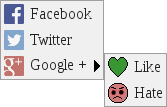jquery.easymenu 
jQuery menu plugin. Create menus really easy and attach them to elements, as context menus, or by way of some other event. Supports action callbacks for when a menu option is selected, separators, icons and sub menus.
Here are examples of a really basic menu, one with Font Awesome icons (by way of CSS classes), a menu with colour image icons and a sub menu, and finally a menu with a block of raw HTML in it:

![]()


All these menus are shown working live in the demo (in the 'demo' folder
of the easymenu distribution). The demo is likely not to work if you
access it via the file system because the browser will hit cross
origin restrictions, so, if you are an NPM user you can run npm install
to install the development and demo dependencies, followed by
./node_modules/http-server/bin/http-server demo to run a web server
for the demo files, or otherwise you will have to copy the files to
a web server, and fix the dependencies (Easy Menu, jQuery and
Font Awesome).
Synopsis
Create a simple menu with three options and attach it to an element with ID 'my-thing-with-menu'. The default trigger is a 'contextmenu' event, so right clicking the target element will display the menu, but a third parameter to 'attach' specifying the event name can change this (e.g. you could specify 'click' or 'dblclick'):
let menu = ;; let menu_items = label: 'Option 1' { ; } label: 'Option 2' { ; } label: 'Option 3' { ; } ; menu; menu;Contents
Getting started
Create a simple menu
First create or reference a table element within the DOM:
let menu = ;;Turn it into a jQuery easymenu:
menu;Attach the menu where you want it:
menu;The menu_items parameter passed to the easymenu constructor describes
the menu by way of a list of menu items. Each menu item is an object, with
various keys and values determining its characteristics.
A type key determines the type of a menu item, but, conspicuously missing
above, it defaults to 'option'.
Other types add different things into the menu, and other keys and values in the object change the menu item in other ways.
Additional features
Adding a separator
A separator is achieved by adding a menu item of type 'separator':
menu;Adding a header
A header is achieved by adding a menu item of type 'header':
menu;This could be achieve by CSS and classes, or a block; this is just a convenient short hand.
Adding icons
An icon can be added to a menu item by adding an icon key to it.
The value must be an object with either a file or class sub key.
Image icons
menu;Class icons
menu;Adding a block
A menu item of type 'block' has simple the contents of the label inserted:
menu;Adding a sub menu
A sub menu is added by including a sub_menu key. The value must be
as the object parameter passed to construct a jQuery easymenu object:
menu;The value of sub_menu will be taken and used to create another
easymenu menu, which will be attached to the first/root menu...
Adding titles
A title (which shows helpful information (or rude comments if you
like) when hovering over a menu item) can be added to a menu item
by including a title key:
menu;Using other events
Passing a third parameter to attach you can specify alternative
events. The default event is contextmenu, so this:
menu;Is the same as:
menu;You could however specify this:
menu;Or any other event the target element can receive...
Other methods
show
Show displays the menu. Because no event is involved the X and Y position must be given:
menu;hide
This hides the menu:
menu;